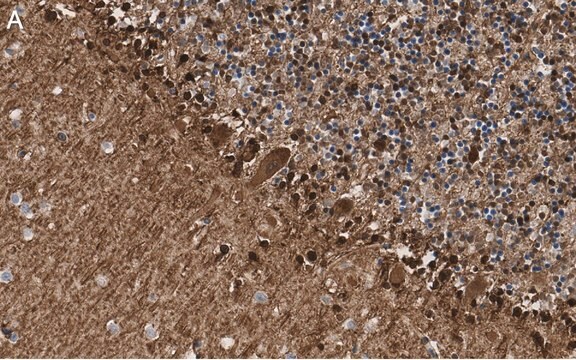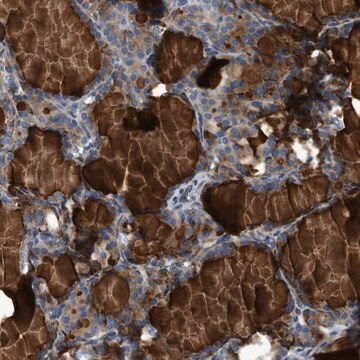ZRB2183
Anti-SUCNR1/GPR91 Antibody, clone 1N21 ZooMAb® Rabbit Monoclonal

recombinant, expressed in HEK 293 cells
동의어(들):
Anti-CD11a Antibody, clone 2J15 ZooMAb® Rabbit Monoclonal, G-protein coupled receptor 91, P2Y purinoceptor 1-like, Succinate receptor 1
About This Item
추천 제품
생물학적 소스
rabbit
Quality Level
재조합
expressed in HEK 293 cells
결합
unconjugated
항체 형태
purified antibody
항체 생산 유형
primary antibodies
클론
1N21, recombinant monoclonal
설명
recombinant, expressed in HEK 293 cells
제품 라인
ZooMAb® learn more
형태
lyophilized
분자량
calculated mol wt 38.7 kDa
정제법
using Protein A
종 반응성
porcine, human
포장
antibody small pack of 25
환경친화적 대안 제품 특성
Waste Prevention
Designing Safer Chemicals
Design for Energy Efficiency
Learn more about the Principles of Green Chemistry.
향상된 검증
recombinant expression
Learn more about Antibody Enhanced Validation
sustainability
Greener Alternative Product
기술
ELISA: suitable
affinity binding assay: suitable
immunofluorescence: suitable
immunohistochemistry: suitable
western blot: suitable
동형
IgG
에피토프 서열
C-terminal half
단백질 ID 수납 번호
UniProt 수납 번호
환경친화적 대안 카테고리
배송 상태
ambient
저장 온도
2-8°C
유전자 정보
human ... SUCNR1(56670)
일반 설명
특이성
면역원
애플리케이션
Evaluated by Immunohistochemistry (Paraffin) in Human breast cancer tissue sections.
Immunohistochemistry (Paraffin) Analysis: A 1:100 dilution of this antibody detected SUCNR1/GRP91 in Human breast cancer tissue sections.
Tested Applications
Affinity Binding Assay: A representative lot of this antibody bound SUCNR1/GPR91 peptide with a KD of 3.5 x 10^-8 in an affinity binding assay.
Western Blotting Analysis: A 1:1,000 dilution from a representative lot detected SUCNR1/GPR91 in human adipose tissue lysates.
Enzyme Immunoassay (ELISA) Analysis: A serial of dilutions from a representative lot detected SUCNR1/GPR91 in SUCNR1 and GST Proteins.
Immunofluorescence Analysis: A 1:5,000 dilution from a representative lot detected SUCNR1/GPR91 in Human liver and porcine kidney tissue sections.
Note: Actual optimal working dilutions must be determined by end user as specimens, and experimental conditions may vary with the end user.
표적 설명
물리적 형태
재구성
저장 및 안정성
법적 정보
면책조항
적합한 제품을 찾을 수 없으신가요?
당사의 제품 선택기 도구.을(를) 시도해 보세요.
Storage Class Code
11 - Combustible Solids
WGK
WGK 1
Flash Point (°F)
Not applicable
Flash Point (°C)
Not applicable
시험 성적서(COA)
제품의 로트/배치 번호를 입력하여 시험 성적서(COA)을 검색하십시오. 로트 및 배치 번호는 제품 라벨에 있는 ‘로트’ 또는 ‘배치’라는 용어 뒤에서 찾을 수 있습니다.
자사의 과학자팀은 생명 과학, 재료 과학, 화학 합성, 크로마토그래피, 분석 및 기타 많은 영역을 포함한 모든 과학 분야에 경험이 있습니다..
고객지원팀으로 연락바랍니다.







